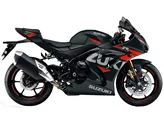Yamaha R1 2011 vs. Suzuki GSX-R 1000 2017

Yamaha R1 2011

Suzuki GSX-R 1000 2017
Vue d’ensemble - Yamaha R1 2011 vs Suzuki GSX-R 1000 2017
The Yamaha R1 model year 2011 and the Suzuki GSX-R 1000 model year 2017 are both high-performance supersport motorcycles that offer impressive specifications and features.
In terms of engine and drive train, the Yamaha R1 2011 is equipped with a 998cc engine that produces 181 horsepower and 115.5 Nm of torque. It has a bore of 78 mm and a stroke of 52.2 mm. The bike features a 4-cylinder DOHC engine with 4 valves per cylinder. On the other hand, the Suzuki GSX-R 1000 2017 has a slightly smaller engine displacement of 999cc but delivers a higher power output of 202 horsepower and 118 Nm of torque. It has a bore of 76 mm and a stroke of 55.1 mm. Similar to the Yamaha R1, the GSX-R 1000 also has a 4-cylinder DOHC engine with 4 valves per cylinder.
Both motorcycles feature upside-down telescopic forks for the front suspension and aluminum frames, which provide excellent stability and handling. The Yamaha R1 2011 has a Deltabox frame, while the Suzuki GSX-R 1000 2017 has a Twin Tube, Twin-Spar frame.

Yamaha R1 2011
In terms of braking, both bikes are equipped with double disk brakes at the front. They also have the same tire dimensions, with a front tire width of 120 mm and a rear tire width of 190 mm. The tire diameter for both bikes is 17 inches.
In terms of dimensions and weights, the Yamaha R1 2011 has a wheelbase of 1415 mm and a seat height of 835 mm. It has a fuel tank capacity of 18 liters. On the other hand, the Suzuki GSX-R 1000 2017 has a slightly shorter wheelbase of 1410 mm and a lower seat height of 825 mm. It has a fuel tank capacity of 17.5 liters.

Suzuki GSX-R 1000 2017
Now, let's discuss the strengths and weaknesses of each motorcycle. The Yamaha R1 2011 is praised for its fine traction point, making it easy for riders to adapt to different race tracks. It also has easy steering behavior and offers optimal traction. However, one weakness of the Yamaha R1 2011 is its plump-looking rear end, which may not be visually appealing to some riders.
On the other hand, the Suzuki GSX-R 1000 2017 has several strengths. It has a high-revving engine and a torque curve without any dents, providing a smooth and powerful performance. The bike is also super stable on corner exits and radius, making it a great choice for fast tracks. It features a great quickshifter and a high-quality chassis. However, one weakness of the GSX-R 1000 2017 is that its engine brake is not adjustable, which may limit the customization options for some riders.
In conclusion, both the Yamaha R1 2011 and the Suzuki GSX-R 1000 2017 are impressive supersport motorcycles with their own unique strengths and weaknesses. The Yamaha R1 2011 offers easy rider adaptation and optimal traction, while the Suzuki GSX-R 1000 2017 boasts a high-revving engine and superb stability on fast tracks. Ultimately, the choice between these two models will depend on the rider's preferences and priorities.
Caractéristiques techniques Yamaha R1 2011 par rapport à Suzuki GSX-R 1000 2017
Avantages et inconvénients en comparaison
Avantages et inconvénients en comparaison
Yamaha R1 2011

Autrefois, elle était la bête la plus coriace parmi les 1000. Seuls les chiens les plus féroces pouvaient la monter. Aujourd'hui, elle est la moto que l'on peut qualifier non seulement de "moindre mal sur la route", mais qui procure également beaucoup de plaisir.
Suzuki GSX-R 1000 2017

Suzuki a réussi à rendre la GSX-R 1000 2017 géniale. Une moto puissante comme un ours avec une courbe de couple incroyablement douce. Incroyable avec 202 ch ! Le châssis est de grande qualité et l'électronique n'a pas de paillettes, mais elle offre des performances exceptionnelles.
Comparaison des prix Prix moyen du marché Yamaha R1 vs Suzuki GSX-R 1000
There are a few key differences between a Yamaha R1 2011 and a Suzuki GSX-R 1000 2017. There are the same number of bikes of both models available on the 1000PS.de marketplace, specifically 4. It takes less time to sell a Yamaha R1 with 53 days compared to 121 days for a Suzuki GSX-R 1000. Since model year 2005 1000PS.de editors have written 80 reviews for the Yamaha R1 and 71 reviews for the Suzuki GSX-R 1000 since model year 2005. The first review for the Yamaha R1 was published on 4/28/2003 and now has more than 3,900 views. This compares to more than 7,100 views for the first review on Suzuki GSX-R 1000 published on 3/3/2004.


















